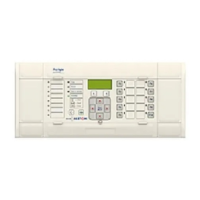Na7
-
MiCOM P741, P742
The other advantage of using an instantaneous sum lies in the speed of decision, which in
turn is dictated by the sampling frequency.
Differential currents may also be generated under external fault conditions due to CT error.
To provide stability for through fault conditions the relay adopts a biasing technique, which
effectively raises the setting of the relay in proportion to the through fault current thereby
preventing relay maloperation.
The bias current is the scalar sum of the currents in the protected zone and for the check
zone. Each of these calculations is done on a per phase basis for each node and then
summated.
1.1.2.1 Bias Characteristic and Differential current
The operation of the busbar differential protection is based on the application of an algorithm
having a biased characteristic, (Figure 2) in which a comparison is made between the
differential current and a bias or restraining current. A trip is only permitted if this differential
current exceeds the set slope of the bias characteristic. This characteristic is intended to
guarantee the stability of protection during external faults where the scheme has current
transformers with differing characteristics, likely to provide differing performance.
The algorithm operands are as follows:
Differential Current
i
diff
(t) = Σ i
Bias or Restraining current
i
bias
(t) = Σ i
Slope of the bias characteristic
kx
Tripping permitted by bias element for:
i
diff
x(t) > kx x i
bias
(t)
The main differential current element of P74x will only be able to operate if the differential
current reaches a threshold I
D
x>2. In general, this setting will be adjusted above the normal
full load current.
1.1.2.2 Scheme supervision by "check zone” element
The use of a "check zone" element is based on the principle that in the event of a fault on
one of the substation busbars, the differential current measured in the faulty zone will be
equal to that measured in the entire scheme.
One of the most frequent causes of maloperation of differential busbar protection schemes is
an error in the actual position of an isolator or CB in the substation to that replicated in the
scheme (auxiliary contacts discrepancy). This would produce a differential current in one or
more current nodes. However, if an element monitors only the currents "entering" and
"leaving" the substation, the resultant will remain negligible in the absence of a fault, and the
error will lie with the zone’s assumption of the plant position at this particular point in time.

